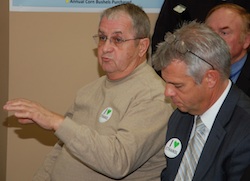JatroDiesel’s technology has been selected by Patriot Renewable Fuels for its 4-5 million biodiesel facility under construction next to its ethanol plant in Annawan, Illinois. The biodiesel plant, when it goes into operation in September 2014 will use the corn oil produced during the ethanol process for its primary feedstock. To learn more about the multi-feedstock biodiesel technology, I spoke with Raj Mosali, CEO of Jatro Diesel.
 How did you get into the biodiesel industry?
How did you get into the biodiesel industry?
“I would say it was serendipity,” said Mosali. We wanted to do something in the industry. We began developing the technology in the garage. The first iteration was a bad system that could only use soy. Today, they have developed the technology for a fully continuous plant that produces biodiesel from multi-feedstocks.
What types of technologies did you develop?
We have two types of technologies, answered Mosali. One is traditional (catalysts, acid and methanol) and one is super critical methanol-based technologies that is being used for Patriot’s biodiesel facility. When using super critical technology, they are eliminating the use of both catalysts and acid in the process. They achieve the same results by using temperature and pressure. Also with super critical technology the glycerin produced is 95 percent pure or higher and this brings in additional revenue.
Are issues surrounding free fatty acids (FFA) a thing of the past?
Masali said that super critical processing can utilize any feedstock up to 100 percent FFA. Due to this ability, there is no restriction on what the technology can do and no restrictions on what kinds of feedstocks they can use as well as no restrictions on what kinds of FFA’s they come in with. In addition, there is about 5 percent of FFAs that until now no one can use, but this technology can such as yellow grease.
 Why it is a good idea to co-locate the biodiesel facility next to an ethanol plant?
Why it is a good idea to co-locate the biodiesel facility next to an ethanol plant?
It is a huge, huge advantage whenever you vertically integrate a biodiesel plant with the source of the feedstock, explained Mosali. The savings come from the trucking and other economics that typically go into transporting the feedstock. He believes pretty soon most ethanol plants will follow the lead of what Patriot is doing.
What type of project is best suited for your technology?
Mosali said that the best type of project for their technology is a greenfield project because of all the elements needed for this technology, but it’s not out of the question to convert a shuttered biodiesel plant to use their technology.
Listen to my full interview with Raj Mosali here: A Q&A with JatroDiesel
Check out the Patriot Renewable Fuels photo album.











